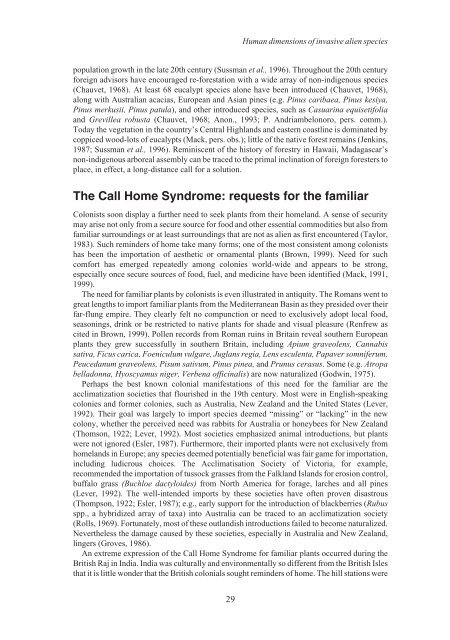Alien Species.vp - IUCN
Alien Species.vp - IUCN
Alien Species.vp - IUCN
You also want an ePaper? Increase the reach of your titles
YUMPU automatically turns print PDFs into web optimized ePapers that Google loves.
population growth in the late 20th century (Sussman et al., 1996). Throughout the 20th century<br />
foreign advisors have encouraged re-forestation with a wide array of non-indigenous species<br />
(Chauvet, 1968). At least 68 eucalypt species alone have been introduced (Chauvet, 1968),<br />
along with Australian acacias, European and Asian pines (e.g. Pinus caribaea, Pinus kesiya,<br />
Pinus merkusii, Pinus patula), and other introduced species, such as Casuarina equisetifolia<br />
and Grevillea robusta (Chauvet, 1968; Anon., 1993; P. Andriambelonoro, pers. comm.).<br />
Today the vegetation in the country’s Central Highlands and eastern coastline is dominated by<br />
coppiced wood-lots of eucalypts (Mack, pers. obs.); little of the native forest remains (Jenkins,<br />
1987; Sussman et al., 1996). Reminiscent of the history of forestry in Hawaii, Madagascar’s<br />
non-indigenous arboreal assembly can be traced to the primal inclination of foreign foresters to<br />
place, in effect, a long-distance call for a solution.<br />
The Call Home Syndrome: requests for the familiar<br />
Colonists soon display a further need to seek plants from their homeland. A sense of security<br />
may arise not only from a secure source for food and other essential commodities but also from<br />
familiar surroundings or at least surroundings that are not as alien as first encountered (Taylor,<br />
1983). Such reminders of home take many forms; one of the most consistent among colonists<br />
has been the importation of aesthetic or ornamental plants (Brown, 1999). Need for such<br />
comfort has emerged repeatedly among colonies world-wide and appears to be strong,<br />
especially once secure sources of food, fuel, and medicine have been identified (Mack, 1991,<br />
1999).<br />
The need for familiar plants by colonists is even illustrated in antiquity. The Romans went to<br />
great lengths to import familiar plants from the Mediterranean Basin as they presided over their<br />
far-flung empire. They clearly felt no compunction or need to exclusively adopt local food,<br />
seasonings, drink or be restricted to native plants for shade and visual pleasure (Renfrew as<br />
cited in Brown, 1999). Pollen records from Roman ruins in Britain reveal southern European<br />
plants they grew successfully in southern Britain, including Apium graveolens, Cannabis<br />
sativa, Ficus carica, Foeniculum vulgare, Juglans regia, Lens esculenta, Papaver somniferum,<br />
Peucedanum graveolens, Pisum sativum, Pinus pinea, and Prunus cerasus. Some (e.g. Atropa<br />
belladonna, Hyoscyamus niger, Verbena officinalis) are now naturalized (Godwin, 1975).<br />
Perhaps the best known colonial manifestations of this need for the familiar are the<br />
acclimatization societies that flourished in the 19th century. Most were in English-speaking<br />
colonies and former colonies, such as Australia, New Zealand and the United States (Lever,<br />
1992). Their goal was largely to import species deemed “missing” or “lacking” in the new<br />
colony, whether the perceived need was rabbits for Australia or honeybees for New Zealand<br />
(Thomson, 1922; Lever, 1992). Most societies emphasized animal introductions, but plants<br />
were not ignored (Esler, 1987). Furthermore, their imported plants were not exclusively from<br />
homelands in Europe; any species deemed potentially beneficial was fair game for importation,<br />
including ludicrous choices. The Acclimatisation Society of Victoria, for example,<br />
recommended the importation of tussock grasses from the Falkland Islands for erosion control,<br />
buffalo grass (Buchloe dactyloides) from North America for forage, larches and all pines<br />
(Lever, 1992). The well-intended imports by these societies have often proven disastrous<br />
(Thompson, 1922; Esler, 1987); e.g., early support for the introduction of blackberries (Rubus<br />
spp., a hybridized array of taxa) into Australia can be traced to an acclimatization society<br />
(Rolls, 1969). Fortunately, most of these outlandish introductions failed to become naturalized.<br />
Nevertheless the damage caused by these societies, especially in Australia and New Zealand,<br />
lingers (Groves, 1986).<br />
An extreme expression of the Call Home Syndrome for familiar plants occurred during the<br />
British Raj in India. India was culturally and environmentally so different from the British Isles<br />
that it is little wonder that the British colonials sought reminders of home. The hill stations were<br />
29<br />
Human dimensions of invasive alien species












